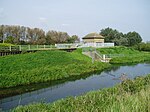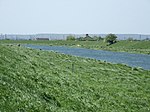Tongue End

Tongue End is a small village in the South Holland district of Lincolnshire, England. It is situated 4 miles (6 km) east from Bourne and 6 miles (10 km) south-west from Spalding, and alongside the Counter Drain that runs between Baston and Pode Hole. Tongue End comprises Victorian red-brick farmworkers' cottages and early 20th-century former council houses. It once had a village school (built in 1876), and three public houses.The name is said to refer to the shape of the land between the rivers Glen and Bourne Eau. There is a location on the Stamford Canal which is similarly formed and has the same name.Tongue End falls within the drainage area of the Welland and Deepings Internal Drainage Board. Gilbert Heathcote's tunnel drained into the Counter Drain nearby.
Excerpt from the Wikipedia article Tongue End (License: CC BY-SA 3.0, Authors, Images).Tongue End
Counter Drain Drove, South Holland Deeping St. Nicholas
Geographical coordinates (GPS) Address Nearby Places Show on map
Geographical coordinates (GPS)
| Latitude | Longitude |
|---|---|
| N 52.75371 ° | E -0.2801 ° |
Address
Counter Drain Drove
Counter Drain Drove
PE11 3JL South Holland, Deeping St. Nicholas
England, United Kingdom
Open on Google Maps










